#ape escape million monkeys
Explore tagged Tumblr posts
Text
Happy Birthday Jeremy Jordan the voice actor of Otto (オットー) and also I inserted Lab Rat (ラボネズ) and Otto (オットー) in this Japanese exclusive PS2 game called Ape Escape Million Monkeys (サルゲッチュ! ミリオンモンキーズ)

#superkitties#スーパーキティ#superkitties supurr charged#superkittiessupurrcharged#スーパーキティニャンダフル・チャージ#ape escape million monkeys#saru getchu million monkeys#サルゲッチュ! ミリオンモンキーズ#サルゲッチュ#saru getchu#ディズニージュニア#disney junior#japan studio#Sony Computer Entertainment Inc#SonyComputerEntertainmentInc#japanstudio#ps2#PlayStation 2#PlayStation2#プレイステーション2
2 notes
·
View notes
Text
youtube
Soichi Terada - Ape Escape: Million Monkeys - Stadium
3 notes
·
View notes
Text

we need to go back, back to the past to save the future. god I miss low poly
2 notes
·
View notes
Text
I’m hyperfixated on Ape Escape so here’s some plushies I made (my Comms are also open FOR REAL this time)


The Pipotron trio have always been my favorite, particularly Blue. I made all 3 bc I couldn’t resist lol


These gorls are my OCs, Marine and Proto(type). In the fanfic I’m writing tho she’s referred to as Green by some but Proto by most.
And finally, everyone’s favorite albino boi, Specter. I used his Million Monkeys design bc that one is my favorite.




Also, bonus— my brother paid me to revive one of my ancient childhood OCs in the form of a plush. I’d rather have forgotten Pipotron Orange existed, but $70 is $70 😂


#ape escape#pipotron#ape escape specter#custom plush#custom made#plush commissions#plushmaker#ape escape OCs#if you’re interested in one Pipotron are $70#a specter like the one shown is $150#sorry if that seems too expensive#anyway thanks for looking at my plushies ;;
23 notes
·
View notes
Text

In the Anectyocene North America is one of the most biodiverse continents, thanks to the extreme variety of biomes, and having a biosphere much more different than the rest of the world. Its ten million years isolation from Afro-Eurasia, and partial isolation from South America, thanks to both mountains and the rainforest not allowing bigger pampas and chaco dwellers to reach the northern continent, allowed it to develop much more distinct ecosystems.
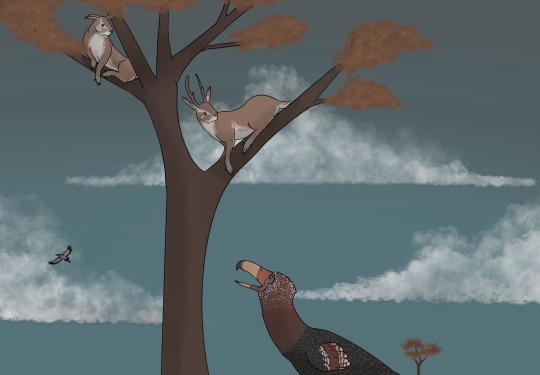
One of the most diverse and common clades in the continent are Lepolopidae, walking or running jackrabbits inhabiting both the grasslands, the redwood forests in the west and the humid forests in the east, that diverge in many ways from their Eurasian cousins.
They’ve developed antlers instead of tusks (or horns in some cases), and evolved their outermost toes into opposable and semi-opposable digits, allowing them to become quite skilled climbers, letting them browse on trees regardless of their height, and helping them escape from land dwelling predators.
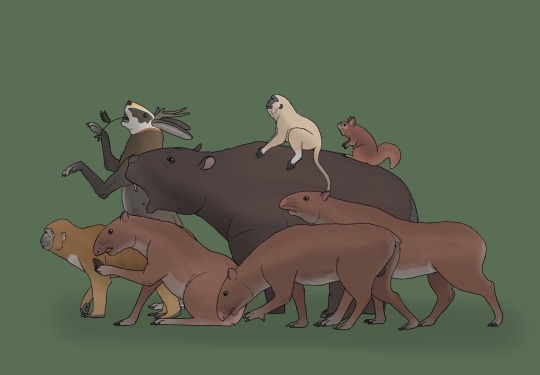
Another quite diverse group of herbivores are the Mayarrhinidae, agouti descendants that came from Central America and expanded into the rest of the continent, that consume almost every kind of plant matter and are quite important seed dispersers of evergreens and oak-trees.
The most important seed dispersers of the continent, tho, are monkeys, especially macaques, whose expansion northwards allowed the expansion of many plants descended from feral fruit producing species.
North American monkeys are all descended from four ancestral introduced species: squirrel monkeys, capuchins, crab eating macaques and rhesus macaques. The first two are for the most part limited to Florida, and on a lesser degree the denser parts of the southern US’ forests, while the two macaques have an almost continent-wide range, going from British Columbia to Sinaloa, and from California to Newfoundland. Thanks to the absence of primates in these areas these macaques have been able to undergo an adaptive radiation, giving life to the polyphyletic group of the New World macaques (Bibliopithecinae, for the rhesus descendants, and Galactopithecinae, for the crab-eater descendants), and resulting in a myriad of forms resembling baboons, geladas, tamarins (that in some cases even compete with squirrels) and apes.
Many changed diets, becoming grazers, leaf eaters and in one case molluscivorous. The Cyonuropithecus caelurorrhinus is a Galactopithecine part of a gelada like genus inhabiting the areas of the Atlantic coast of Canada and the Northern US. Although the other members of its genus are for the most part grazers their diet is mainly made up of molluscs and crabs that they found on the shore with low tide. For this lifestyle they evolved naked hands and wrists and a stronger bite force. They’re also some of the best primate swimmers, thanks to their partially webbed hands.
Some of the biggest herbivores of the continent evolved from beavers, the biggest surviving rodents, that would become as big as hippos and rhinos, and would graze on the bushes and grasses on the ground. The actual biggest land animals, tho, are the ground porcupines, that came from South America, and being generally good rainforest dwellers were able to pass through Central America with ease.
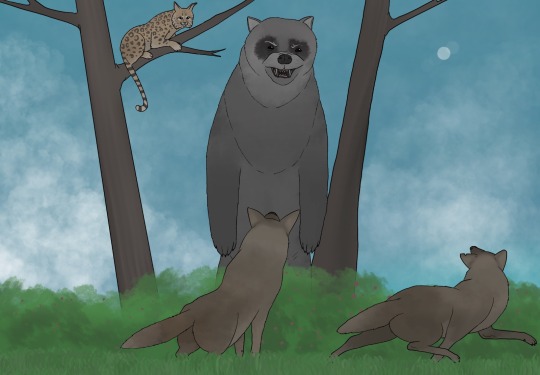
The predators of North America, though, are what really set it apart from the rest of the world, being the only continent, not counting islands like Madagascar, without a mammalian apex predators. Like South America during most of the Cenozoic the continent’s hypercarnivores are birds, more specifically caracara descendants, whose only competitors are the Diacyonines, bear-like raccoon descendants with an omnivorous diet. The other main predatory clades of the continent are the Latrantocyonines, wolf analogues descended from coyotes, and partially from dogs too, the Lycornithines, roadrunners that mainly scavenge and hunt small game, and Bizofelines, descendants of domestic cats that are now arboreal lynx like hunters, and effective mountain dwellers too.
https://discord.gg/KjusGndh discord link if u wanna join the project’s server
#spec evo#spec bio#speculative evolution#speculative biology#artwork#worldbuilding#digital art#epigene period#future earth
16 notes
·
View notes
Text
Random question to tumblr:
Ever play/heard of Ape Escape? Or Magic Pengel / Graffiti Kingdom? A friend claims Ape Escape is too obscure and I swear I've only seen like one other person even aware of Pengel OR Graffiti Kingdom (but never BOTH).
No I'm not going to be more specific with Ape Escape games in general, ANY of them will count (1, 2, 3, the dead 4, 1 PSP port, Ape Quest, Million Monkeys, Ape Academy, the party game...).
Also playing includes ANY amount of play not necessarily to completion.

#tumblr polls#random polls#random question#gaming#ps2 games#ps1 games#ape escape#magic pengel#graffiti kingdom
6 notes
·
View notes
Text
"King Kong" (1976) Blog Essay
By: Dayanara Ramos
The 1976 remake of "King Kong" is not exactly a regurgitation of the 1933 film with the monster included, but rather a process of cinematic development like the socioeconomic anxieties of the time mirrored in the story. Instead of being a visual copy of the 1933 film, it is visually surreal in that it revisits the visual style of the 1976 version directed by John Guillermin and produced by Dino De Laurentiis and is a more adventure-like version of the original story. Nevertheless, it utterly makes that by taking the frame of early 1970's USA, exchanging the movie crew. The interconnection of present-day economic issues into the plot is also achieved in a subtle and skillful manner. The film "King Kong" (1976) was released in theatres by Paramount Pictures, and it premiered on December 17, 1976. Acting as a $24-m budget film, the picturesque landscapes and incredible mechanical Kong were supposed to be the attractive features of the events and impress the audiences of the 1970s. The plot is centered on the oil crew of Fred Wilson (Charles Grodin) who by some way meets the mighty monkey King Kong on the island where they fortunately landed on to conduct the expedition. They resolve to bring the primate to New York in an ambitious enterprise that will get them millions of dollars and wealth. Even though the movie is about the relationship between Kong and Dwan (played by Jessica Lange) in her first role after the shipwreck will be saved from it. A beautiful lady and a monstrous creature are seen in an unedited gameplay. This is the manifestation of romantic which is a tragedy. With a ravenous audience at the end of 1976, it received quite a mixture of reviews, but nevertheless managed to provide one of the most engaging and breath-taking experiences with box office growth of $90 million worldwide. The famous critics such as Roger Ebert gave it a rating of three out of four stars, cutting off its extraordinary special effects and a more serious and less captivating approach compared to the original. However, some of the dialogues and the pacing of the film were pointed out as shortcomings in the film's making. On the other hand, the performance of Kong (guided by Rick Baker, who designed a suit for ape) garnered kudos from spectators because it functioned to evoke sympathy. This is a significant break from the more monstrous representation used in the previous versions of Beauty and the Beast as suggested by John Kenneth.
The 1970s were a flashing sign of the economic turmoil that culminated with the oil crisis of 1973. The historic context is the key factor that allows one to understand the essence of the given filmmaking; it is introducing the oil exploration as a parallel to the film period greed and self-defeating rapture over the resources. The transition in the plot reflects the environmental and ethical problems of the time, presenting Kong as a victim of corporate exploitation instead of just a movie star.
The "King Kong" film adaptation of 1976 which is different from the original 1933 version in the fact that the film's cinematography is in full color; this makes the escapism of Skull Island more intense and makes the grandeur of the 70s New York more than ever so palpable.
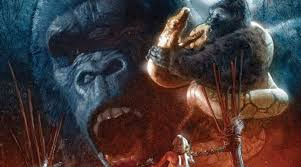
The movie makes use of a romantic and soft approach in Dwan and Kong scenes whose visuals represent this manner immensely. These scenes are obtained with a dreamy effect that shows their developing but finally doomed relationship. The primitiveness of the visual effects, which should be attributed to the period it was produced, was nevertheless ground-breaking in its field, especially on account of the special effects incorporating a life-size model of Kong in some scenes, which provided a tangible yet unwieldy authenticity to the sequences that depicted the monster's interactions.
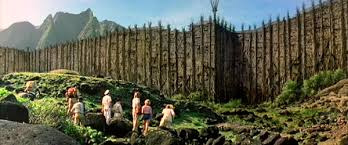
"Kong" (1976) keeps mostly to the plot (read 'motion picture' template) of this type of movie, along with a rare theme of coercion and liberation. Nevertheless, it adds a new aspect by showing how the emotional and moral impact of Kong's capture is more important than the physical aspects. In the film, the screenplay gives Kong another plotline that is emotional and sorrowful, especially in this final moment as he is atop WTC instead of the Empire State Building. It expresses the modern outlook and the creative styling of the metropolitan New York skyline.
In the end, "King Kong" (1976) is a movie that holds a special place in the history of cinema of the 1970s. It is closely related to the cinematic legacy of the 1970s and the social and economic stories of that era. The movie tries to blend magic, the unknown, tragedy, and evolutionary issues by making significant advances around special effects while exploring the sphere of moral congruence profoundly and creatively. With the power to enchant us as the 1933 original does, it is still calm stories of humankind's cruel domination of nature and such a tragic price we pay.
6 notes
·
View notes
Note
I know the Ape Escape Move characters aren’t in your Ape Escape Au but how do think they’ed get along with your version of main Ape Escape cast? Especially how the two different Specters would get along? (Move Specter came off as kinda chill with a kinda soft vibe at the end of his game so it be neat to see how he plays of your more serious with an edgy vibe Specter.)
In complete fairness I'm not sure? I jokingly say that Ape Escape games only have a teaspoon of story to them and I have to make a bunch of shit up to fill in the gaps for my AU, but at least the main series games went on long enough to have like 5 teaspoons of story to pull from (7 if you count the Pumped and Primed and Million Monkeys split, 8 if you want to borrow elements from the anime, etc.) and the characters, though only having a teaspoon of characterization themselves they have kinda big cartoony personalities that you can grab onto. The Ape Escape Move universe has one single game that even it's own teaspoon of story and characterization feel lacking to get a good feel for all the characters :(
We do see early on the two granddaughters are mischievous because of the look they give each other when they convince the protag to help them, giving them an almost manipulative vibe but other than that they don't have much. Grandma and Specter probably had the most personality yet the least screen time. Maybe its just grandma's voice but she has a kind but no nonsense vibe I guess?
The two Specters interacting would be fun to think about but the only thing I can come up with is AEM's Specter just being like "... Wow you're really high strung.... you should take a nap or something?" Because we only get like 3 cutscenes with AEM's Specter and I don't know if I missed something but I have no clue what his motus operandi is ?? They bop him on the head and bring him back to earth and he and grandma are like "Hey? Sup?" and then go home like nothing happened? What is even going on in this game I swear I missed something? ------ Unrelated I love any scene where Specter is getting cradled in human arms he so smol so one good thing I guess?
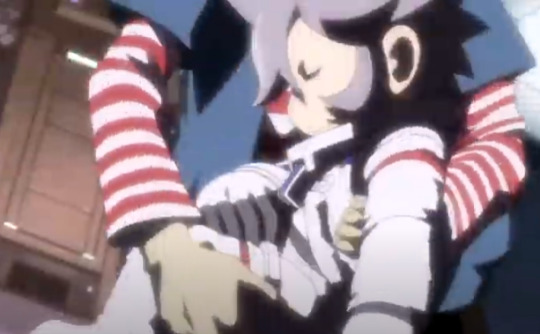
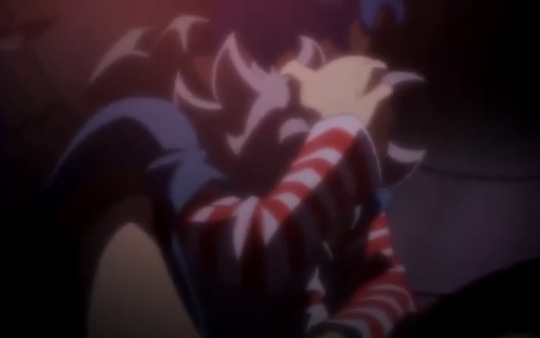
------
Off topic: WHY DID THEY MAKE THE PROTAG SILENT BUT HE HAS TEXT DIALOGUE IN THE CUTSCENES?! WAS IT TO MAKE IT EASIER FOR THE PLAYER TO PROJECT THEMSELVES ON HIM? BECAUSE I'M NOT A BLUE HAIRED MAN WITH A JELLYBEAN FACE AND DUMPY PANTS SO WHAT WAS THE POINT JUST LET HIM BE A CHARACTER WITH A FACE AND SPOKEN DIALOGUE????
8 notes
·
View notes
Text
Film Within a Film
“Argo” and “Sinister.”
By Anthony Lane
October 8, 2012
The new Ben Affleck movie, “Argo,” begins in November, 1979, with the storming of the American Embassy in Tehran. A crowd breaks into the compound, taking more than fifty Americans hostage. Six escape through the back of the building and take refuge in the residence of the Canadian Ambassador. How can they be spirited out of the country, or, as the jargon puts it, exfiltrated? Back in Washington, the task falls to a C.I.A. staffer named Tony Mendez (played by Affleck), from the Office of Technical Services. Various plans have been mooted, the most credible being that the hostages could make it to the border, hundreds of miles away, on bikes. Mendez, however, has an even better idea. Well, not a better one, but a more ridiculous one: how about making a movie?
Enter John Chambers (John Goodman), a prosthetics guru whose work on simian features, for “Planet of the Apes,” earned him an Academy Award, in 1969, and whose talents the Agency has called on in the past. Mendez goes to Hollywood and asks Chambers to devise a nonexistent film: find a script that requires a Middle Eastern setting, and build up a simulacrum of a genuine production. Posters, storyboards, costumes, read-throughs, buzz in the trade papers: everything will help. Mendez, posing as an associate producer, will fly to Iran, issue false identities to the six Americans, claim that they are scouting locations for a Canadian science-fiction movie, and then fly them out.
Four things should be said about this pipe dream. One, it went ahead; two, it worked; three, it wasn’t declassified until 1997; and four, it makes for a good movie, and further proof that we were wrong about Ben Affleck. Few of us, watching “Armageddon” and “Pearl Harbor,” could see a way out, or back, for an actor so utterly at the mercy of his own jawline. Did he flinch at a future composed of all-American strivers, each more earnest than the last, or had he always been nipped by the directing bug? Whatever the case, Affleck was suddenly there with “Gone Baby Gone” (2007), which was more roughened by energies and doubts than all his performances combined. He took the precaution of recruiting actors more formidable than himself—Morgan Freeman and Ed Harris—to boost his endeavors, and that habit remains. “Argo” has Victor Garber as the Canadian Ambassador, Bryan Cranston as Mendez’s superior, and, most enjoyable of all, Alan Arkin as Lester Siegel, a producer so scornfully amused by Mendez’s request that he has no option but to obey it. He does have one proviso. “If I’m doing a fake movie, it’s going to be a fake hit,” he says.
The fake they decide upon is entitled “Argo,” made by a bogus company called Studio Six, and lovingly described by Chambers as “a twenty-million-dollar ‘Star Wars’ ripoff.” I can’t be the only person who ardently wishes that he and Siegel had gone ahead and shot it. Affleck has a lot of fun, perhaps an ounce too much, with the daftness of the film industry; when Mendez, thinking ahead to the hostages’ cover stories, asks whether you can be taught to direct movies in a day, Chambers replies, “You can teach a rhesus monkey to be a director in a day.” No one is more skilled than Goodman, with his faintly bullying geniality, at dishing up lines like that, but must we buy his character’s implication that Hollywood is just another planet of the apes? Is it good for mendacity, and nothing else?
This matters because “Argo” is, in part, a battle of the textures. When it comes to period detail, Affleck seems to take his cue from Mendez, who worked for the Graphics and Authentication Division of the O.T.S.; just look at the typography of the opening credits, with its bulbous seventies curves. Affleck’s beard and hair style suggest someone who moonlighted from the intelligence services to pose for “The Joy of Sex,” and, as you study the fashions of the era, you have to ask whether the Ayatollah’s fury was provoked by U.S. support for the Shah or, more simply, by the width of Western shirt collars. Everything about the Tehran sequences, in fact, is a rebuke to style. The camera work is anxious and twitching, with a grainy surface to match. Here, we gather, is the real thing: life hemming us in, like a mob.
Then comes the climax. If you visit the C.I.A. Web site, you can read Mendez’s account of events in January, 1980. “As smooth as silk,” he calls the hostages’ passage through the airport, whereas Affleck, chopping up the action and spinning it out, insures that no nails remain unchewed. This is absolutely his right as a teller of tales, and “Argo” never claims to be a documentary. It struck me as a bit rich, however, to make such sport of Hollywood deceitfulness and then to round off your movie with an expert helping of white lies, piling on car chases that never occurred. As for the aftermath, it goes on forever. We get hurrahs for Canadian-American relations; a shot of Mendez hugging his wife, from whom he has been estranged, with the Stars and Stripes fluttering behind; images of the actual hostages, presumably for any skeptics who still find the film implausible; and, finally, a voice-over from Jimmy Carter, lauding the efforts of those involved. All this is, frankly, uncool—a pity, because the rest of “Argo” feels clever, taut, and restrained. Why not close with the perfect coda that Mendez himself supplied? “By the time Studio Six folded several weeks after the rescue, we had received twenty-six scripts,” he wrote. “One was from Steven Spielberg.”
At the start of “Sinister,” Ellison (Ethan Hawke) and his family arrive at their new house. “I had to move here. The new story I’m writing is here,” he explains. Hang on, is he proposing this as a basic principle of literary composition? If so, C. S. Lewis must have really stacked up the air miles on the red-eye from North Oxford to Narnia. Ellison’s excuse is that he writes true crime—that shapeless and often shameless genre which is to good crime fiction what pornography is to romance. His latest project—“This could be my ‘In Cold Blood,’ ” he says—concerns a family that was hanged from a tree outside the very house where Ellison now dwells, although somehow he has failed to inform his wife, Tracy (Juliet Rylance), of this cheerful fact. Up in the attic, he stumbles on a clue: a boxful of old Super-8 films, plus, helpfully, a projector on which to show them. Switching it on, he finds himself watching scenes not just of the hanging but of other multiple murders from the past. Who made the film? Or, rather, who made the film?, as Ellison writes on his notepad. The director of “Sinister” is Scott Derrickson, who co-wrote the script with C. Robert Cargill, and we can but pray that they move on to a new bio-pic of Melville. Imagine his questions: one leg only? and why a whale?
The insertion of found footage into horror flicks is now so common as to be almost compulsory, like the use of vomiting in mainstream comedies. What a golden age we inhabit. Ellison, peering at the clips, spies a masked figure known as Mr. Boogie; though that sounds like a bad compilation album from 1975, it refers to a mythological thief of souls, thus plunging the film into the lair of the unnatural. Nothing wrong with that—irrational terrors beset another writer, and his long-suffering family, in “The Shining.” But Kubrick had the common sense to keep the lights on in the Overlook Hotel, and the wit to infuse a simple, carpeted corridor with unease, whereas Derrickson is playing with loaded dice. How can you hope, or presume, to crank up our dread of the inhuman when, from the start, you refuse to play by regular human rules? Throughout “Sinister,” the rooms remain darker than crypts, whether at breakfast or dinnertime, and the sound design causes everything in the house to moan and groan in consort with the hero’s worrisome quest. I still can’t decide what creaks the most: the floors, the doors, the walls, the dialogue, the acting, or the fatal boughs outside.
None of this is fair to Ethan Hawke. From “Dead Poets Society” to “Reality Bites” and “Before Sunrise” to his modern-day “Hamlet,” where he soliloquized on a video display, Hawke was the standard-bearer of the adolescent temper, as it wrestled its way into adulthood. The gauntness, the waves of intensity, the smarting humor: they all made sense, as if his duty, wherever he trod, were to spread a little Hamletry. As Ellison, he looks unhappy and lost, not because some smirking demon wants to joint him like a chicken and drag him to Hell, which can happen to anyone in this kind of film, but because the prison of middle age, dank with fatherhood and money troubles, is no place for a prince, or for a kid who once dreamed of living like one. “Sinister” is a joyless ride, and its frights are too contrived to be surprising, yet somewhere, stashed in the attic, is a much less foolish film with Hawke at its heart. The only problem is, who will make the film?
0 notes
Text
Color: Pink
Food: Pizza,Strawberry Mochi,Strawberry Donut's, Strawberry Shortcake And Strawberry Ice Cream
Beverage: Strawberry Flavored Fanta And Strawberry Flavored Ramune
Movie: Puella Magi Madoka Magica The Movie III Rebellion,Tinker Bell Movie's, Disney's Tangeld,Sailor Moon Eternal And Sailor Moon Cosmos,Cinnamoroll The Movie and Disney's The Little Mermaid (1989)
Tv Show: Precure Franchise,Onegai My Melody,Tokyo Mew Mew,Saru Get You On Air And Saru Get You On Air 2nd,Creamy Mami,Cardcaptor Sakura,Ojamajo Doremi,Princess Tutu,My Little Pony Friendship Is Magic,Hello Kitty Super Cute Adventures,My Little Pony G3,Mermaid Melody,Sailor Moon (1992),Winx Club,Strawberry Shortcake (2003) and Bratz The Animated Series
Video Game: Ape Escape 3,Pokemon Series,Saru Get You SaruSaru Daisakusen,Hatsune Miku Project Mirai DX,Mario Kart Game's, No Straight Roads,Saru Get You Million Monkeys,Nintendogs,Ape Escape (PS1),Kirby Game's,Mario Party Game's,Super Princess Peach,Super Mario Wonder,Super Mario Galaxy 2,Super Monkey Ball Game's,Puyo Puyo Game's,The Legendary Starfy,Princess Peach's Showtime and Super Mario Galaxy
Book: Sailor Moon Manga,Puella Magi Madoka Magica Manga,Mermaid Melody Pichi Pichi Pitch Manga,Fluffy Fluffy Cinnamoroll,Creamy Mami Manga, Codename:Sailor V,Princess Tutu Manga,Pokemon Adventures Manga and Happy Happy Clover
Animal: Cat's,Bunnies,Rabbit's,Chicken's,Horse's,Dog's and Ferrets
Singer: Melanie Martinez,Taylor Swift,Billie Eilish,The AquaBats,Katy Perry,Kero Kero Bonito,Mother Mother,Bo En,Marina And The Diamond's And Jack Stauber
Song: The Void By Melanie Martinez
Time of Day: Afternoon And Sunset
Song Lyric: I gotta escape the void, there is no other choice, yeah
Tryna turn off the voices, the void ate me
Look at the mess I've done, there is nowhere to run, yeah
Holdin' a loaded gun, the void
Like a priest behind confession walls, I judge myself
Kneelin' on a metal grater
Bloody, like a body that has died, and it's myself
Tangled in my own intestines
I gotta escape the void, there is no other choice, yeah
Gotta escape the void - The Void By Melanie Martinez
Emoji: 🌸/💗/💖
Tags: @cozywonderheart , @chaoticedward , @gloomingstar and many more!
reblog with your favorite:
color: purple
food: french fries
beverage: dr pepper
movie: the parent trap
tv show: percy jackson and the olympians
book: neverseen (fight me on this🦅🦅💥💥)
animal: sloth
singer: toss up between taylor olivia maisie gracie and sabrina
song (atm): good luck, babe!
time of day: midnight
song lyric: address the letters to the holes in my butterfly wings, nothing’s forever, nothing’s as good as it seems
emoji: 🧐(im not kidding)
495 notes
·
View notes
Video
youtube
Introducing... my first voice role! You can hear me as Helga in Flip D Switch’s fandub of Ape Escape: Million Monkeys!
#noodle dubs#noodle's voice#voice acting#ape escape#ape escape: million monkeys#fandub#flip d switch#ape escape million monkeys#helga#haruka
12 notes
·
View notes
Text
getting into playing SARU GET YOU - Million Monkeys and damn is this intro a blast to the past, not even a rip on youtube to share so IG Ill have to upload it lol. wish it was translated though.
youtube
2 notes
·
View notes
Text

#ape escape million monkeys#Pipotron J#Mystery Man#monkey madness#so. e3 huh#anyways sorry i dont like#draw anything#lol
25 notes
·
View notes
Text

Saru Getchu: Million Monkey - Promotional Art (Respost from the sarugearchive twitter account)
51 notes
·
View notes
Text

Vacation boy
#ape escape specter#ape escape 2#ape#apeswillescape#ape escape#ape escape 4#ape escape 1#million monkeys#monkey#if you didn't know i like specter#specter for life#i love specter too much#specter is husbando material#specter is too much to handle#specter the monkey#specter is my fav
28 notes
·
View notes